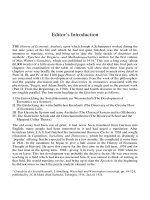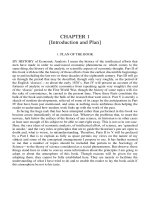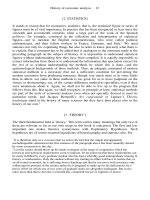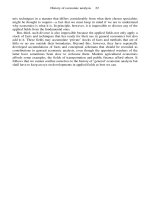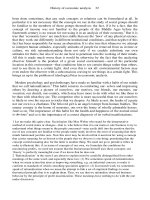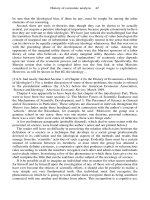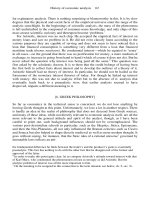History of Economic Analysis part 90 docx
Bạn đang xem bản rút gọn của tài liệu. Xem và tải ngay bản đầy đủ của tài liệu tại đây (63.04 KB, 10 trang )
of both these authors by points culled from the other, though they are at opposite poles in
matters that are of decisive importance analytically. But these attempts have never, so far
as I am aware, gone to the length of trying to revive Marx’s theoretical apparatus.
13
Third, though the Marx vogue in England and in the United States is in part simply the
natural consequence of immigration, it is also something more. On the English or
American student of economics, Marx’s doctrine impinges as something new and fresh,
something that differs from the current stuff and widens his horizon.
14
This impact may
indeed spend itself in scientifically worthless emotions, but it also may prove productive.
In any case, Marx’s influence must be listed among the factors of the scientific situation
of today.
12
I have strongly recommended Sweezy’s Theory of Capitalist Development (1942) as an
admirable presentation of Marx’s (and most of the neo-Marxists’) economic thought. The thing that
calls for notice now is that Dr. Sweezy believes that the economic theory there presented is actually
usable theory ex visu of today and that it is not only equal but superior to the technique used, for
example, by Lange. Still more remarkable, and something of a psychological riddle, is Mrs.
Robinson’s Essay on Marxian Economics (1942). On this, see Mr. Shove’s article, ‘Mrs. Robinson
on Marxian Economics,’ in the Economic Journal, April 1944.
13
One of the most interesting of these attempts has been made by S.Alexander in his paper, ‘Mr.
Keynes and Mr. Marx,’ Review of Economic Studies, February 1940.
14
One reason for this is that Marx has not been and is not being currently taught, especially not in
theory courses. And one reason for this in turn is that he is so difficult to fit in. Because both of his
virtues and of his faults (e.g. because of his diffuseness and repetitiveness that make ‘assignments’
difficult), he either is crowded out or else crowds out the rest of the material teachers feel they
should convey.
History of economic analysis 852
CHAPTER 6
General Economics: Its Character and
Contents
1. OUTPOSTS
(a) The Sociological Framework of General Economics.
1
As we have seen, economic sociology and in particular historical and ethnological
knowledge of social institutions progressed most satisfactorily during the period under
survey. But the general economics on which I am going to report now was but little
affected by these developments. Its institutional framework was left practically
untouched, that is to say, it was left in the shape in which it had been thrown by the
English ‘classics’ and in particular by J.S.Mill. Nations remained amorphous
agglomerations of individuals. Social classes were not living and fighting entities but
were mere labels affixed to economic functions (or functional categories). Nor were the
individuals themselves living and fighting beings: they continued to be mere clotheslines
on which to hang propositions of economic logic. And, with improving rigor of
presentation, these clotheslines stood out even more visibly than they had in the works of
the preceding period.
2
Critics sneered. They saw that all this was poor sociology and even
poorer psychology. Like their predecessors in the first half of the nineteenth century, they
failed to see that, for a limited range of problems, this was at the same time sound
methodology. Owing to the importance of the problems of interpretation involved, I shall
digress for a moment in order to make, once more, an attempt at clarification.
1
I refer again to P.T.Homan, Contemporary Economic Thought (1928). The book deals with the
thought of the period we are discussing rather than with the thought that was ‘contemporary’ in
1928. Another general reference that should be repeated is to G.J.Stigler, Production and
Distribution Theories (1941).
2
This accounts for the survival and even the increased use of two conceptions that were
particularly effective in provoking the critic’s mirth or wrath. First, in order to display certain
aspects of the pure logic of choice, some theorists employed the old concept of an isolated
individual whom they called Robinson Crusoe. The less the critic understood what the theorist was
about, the more he was amused by the picture of economists’ attempting to solve social problems
by ‘drilling Crusoe.’ Second, in order to display other aspects of the pure logic of economic
behavior, some theorists, Pareto for instance, employed the concept of the economic man, homo
oeconomicus. Nothing that was wrong was implied in the actual use they made of it. But critics did
not look at this actual use, but only at the ridiculous caricature itself, which they believed was the
economist’s idea of human nature. Inept defense sometimes made matters worse, though some of
the leaders, Menger and Marshall in particular, said all that should have been necessary to prevent
misunderstanding. The latter’s felicitous phrase, that the economist is studying man in the ordinary
pursuits of business life, went some way in the right direction. Two points should be noted in
addition: first, the fact that the German word, Wirtschaftssubjekt, is not synonymous with economic
man though it has been often thus translated; second, the ease with which the use of the latter term
can be avoided without altering the meaning of the statements in which it occurs—instead of saying
that economic man will do this or that, we can always say that this or that course of action would,
e.g., maximize satisfaction or profit
The Marxists especially but also others accused the marginal utility
theorists of psychologism, that is to say, of entirely missing the true
problem of economics, which is to analyze the objective facts of the social
process of production, and of substituting the completely secondary
problems of the psychological reactions or subjective attitudes of
individuals to those objective facts (see, e.g., K.Kautsky’s remark on the
Austrian school, p. xix of his preface to the first volume of Marx’s
Theorien über den Mehrwert, 1905–10). The Austrians and other groups,
with all their misplaced emphasis upon ‘psychological’ magnitudes, had
only themselves to blame for this mistaken objection, which can be
disposed of, so far as the objectors were Marxists, by pointing out that the
‘new’ theories were hardly more psychological than was that of Marx,
who never hesitated to appeal to capitalists’ psychology (e.g., in the
matter of accumulation) whenever he felt it convenient to do so. In
addition, however, an increasing number of critics objected not indeed to
psychology per se, but to the hedonistic or otherwise unsound psychology
from which economic theorists were supposed to derive their
propositions. These objections will be briefly noticed in another place (see
below, ch. 7). Here, we are concerned with three other sources of criticism
or misunderstanding which, for purposes of identification, we shall label
Political, Sociological, and Methodological Individualism.
By Political Individualism we mean simply a laissez-faire attitude in
matters of economic policy, the attitude that was dubbed Smithianism or
Manchesterism in Germany. Economists who built their theoretical
structures from assumptions about the behavior of individual households
and firms were under suspicion of recommending the results of the free
interplay of individual self-interests which they described. In the eyes of
the critics, this suspicion seemed verified by the facts that many of those
theorists actually were economic liberals in that sense and that some, for
example, Pareto in the first stage of his career, did harness their theory
into the service of an ultra-liberal policy. But this meant no more than
that, like everyone else, the laissez-faire men among the theorists of the
period indulged in the bad habit of giving vent to their political
preferences whenever practical applications were under discussion. As has
been pointed out, however, the majority no longer adhered to unqualified
laissez-faire. It moved with the times. The English and the Austrians
accepted Sozialpolitik and progressive taxation. Marshall professed to be
in sympathy with the ultimate aims of socialism, though he expressed
himself in so patronizing a way as to evoke nothing but irritation. Walras
is best described as a semi-socialist, Wicksell as a bourgeois radical. More
important, however, is it to realize that the political liberalism, so far as
actually espoused by the theorists of the period, had nothing to do with
History of economic analysis 854
their marginal utility theories. Marxists no doubt believed that these had
been excogitated for purposes of social apologetics. But the ‘new’ theories
emerged as a purely analytic affair without reference to practical
questions. And there was nothing in them to serve apologetics any better
than had the older theories. In fact, the contrary would be easier to
maintain (compare, e.g., the equalitarian implications of the ‘law’ of
decreasing marginal utility); and it was ‘bourgeois’ economists who
developed, during that period, the rational theory of the socialist economy
(see below, ch. 7, sec. 5); it was Marshall, Edgeworth, and Wicksell who
reduced the doctrine that free and perfect competition maximizes
satisfaction for all to the level of an innocuous tautology.
3
By Sociological Individualism we mean the view, widely held in the
seventeenth and eighteenth centuries, that the self-governing individual
constitutes the ultimate unit of the social sciences; and that all social
phenomena resolve themselves into decisions and actions of individuals
that need not or cannot be further analyzed in terms of superindividual
factors. This view is, of course, untenable so far as it implies a theory of
the social process. From this, however, it does not follow that, for the
special purposes of a particular set of investigations, it is never admissible
to start from the given behavior of individuals without going into the
factors that formed this behavior. A housewife’s behavior on the market
may be analyzed without going into the factors that formed it. An attempt
to do so may be suggested by considerations of division of labor between
different social disciplines and need not imply any theory about the theme
of Society and Individual. In this case we speak of Methodological
Individualism. How does this concept apply to the actual procedure of the
general economics of that time?
On the one hand, it is true that the formative influences of
environments, group attitudes, group valuations, and so on were not taken
into account in any other way than they had been by J.S.Mill,
4
and that
this was one of the reasons why, in conscious contrast, the historical
school should have emphasized ‘ethical’ aspects as much as it did.
Marshall, who did more in this direction than any other of the leading
3
How independent of political preference the new theory of value
really was is nicely shown by the cases of Walras and Pareto: in matters of
theory, Pareto, who was nothing but a follower of Walras, improved the
latter’s system in a number of technical points; politically there was a
wide gulf between them.
General economics 855
theorists, still remained within established tradition. It is also true that
the failure of theorists to go further than this made itself felt—as it does
now—in their treatment of a number of problems that are nevertheless
‘purely economic.’ On the other hand, however, it may be shown that,
within the range of the problems that primarily interested them, that is
within the range of the problems that come within the logic of economic
mechanisms, the procedure of the theorists of that period may be defended
as methodological individualism, and that their results, so far as they
went, were not substantially impaired by the limitations that are inherent
in this approach.
(b) Population.
As we know, the theory of population, mainly the Malthusian theory, formed an essential
part of the general economics of the preceding period. This means more than that
economists worried about pressure of population and that apprehensions on this score
influenced their vision of the social future and their ideas about economic policy. It
means that hypotheses about actual and expected rates of increase in population entered
into their theorizing just as did the law of decreasing returns, and that in consequence
their theoretical analysis would have been incomplete without those hypotheses. Senior,
therefore, had been quite right when he included a diluted Malthusianism among the
fundamental postulates of economic theory. The essential point to grasp is that this
ceased to be so during the period under survey. No theorist writing in, say, 1890 would
have thought of doing what Senior had done. And this was not primarily because, very
obviously, there was no longer any immediate reason for worrying about pressure of
4
The reader will find an instructive analysis of this range of problems, with particular reference to
Marshall, in two articles by Professor Talcott Parsons in the Quarterly Journal of Economics,
November 1931 and February 1932 (‘Wants and Activities in Marshall’ and ‘Economics and
Sociology: Marshall in Relation to the Thought of His Time’).
History of economic analysis 856
population: it was because the marginal utility system no longer depended upon a
particular hypothesis on birth or death rates and was in a position to take account of
whatever hypothesis an author might think fit to make. Hence the population branch of
general economics tended to wilt and in its place developed a special field, not
necessarily cultivated by economists alone, of population studies. This is why, since we
cannot survey this special field properly, we are no longer vitally interested in the subject
and why we are going to dismiss it with the following three comments.
First, though no longer essential to general economics, a topic that had been essential
for so long was not abandoned quickly. It is of some interest to note that most of the
leaders continued to accept, in one form or another, the Malthusian thesis, at least for an
indefinite future: Böhm-Bawerk, Marshall, Walras (to some extent), and especially
Wicksell,
5
all paid their respects to it, even though they no longer based upon it any part
of their analytic structures. For the rest, an inconclusive discussion pro and con the
Malthusian Law lingered on in textbooks and monographs.
6
Second, the fall in the birth rate that began to set in first in the higher income brackets
then also in the lower, first in towns then also in the country, first in some nations then in
practically all industrialized ones, has in the subsequent period given rise to a sort of
Malthusianism in reverse, that is to say, to widespread concern about the economic
consequences to be expected if birth and death rates should keep on behaving as they did
in the twenties—an extrapolation that, barring details and technique, reproduces
Malthusian
5
Wicksell was particularly emphatic in considering increase of numbers as the main danger to an
ever-increasing standard of life of the working class—so much so that he got himself into trouble
with the Swedish government. Let us note in passing that he revived the concept of optimum
population. On this, see L.Robbins, ‘The Optimum Theory of Population’ (in Gregory and Dalton
eds., London Essays in Economics in Honour of Edwin Cannan, 1927). Concerning ‘Pareto on
Population,’ see Professor J.J.Spengler’s instructive articles in the Quarterly Journal of Economics,
August and November 1944.
6
Perhaps I ought to mention, as standing out from the rest: Professor F.A.Fetter’s youthful essay,
Versuch einer Bevölkerungslehre (1894); F.Oppenheimer’s Das Bevölkerungsgesetz des
T.R.Malthus (Law of Population, 1900); and A.Loria’s Malthus (1909). For general surveys see
R.Gonnard, Histoire des doctrines de la population (1923) and F.Virgilii, Il problema della
popolazione (1924). A curious flare-up of the discussion (Economic Journal, December 1923)
should be noticed if only in order to illustrate the mental processes of economists. At the threshold
of a period of unsalable masses of foodstuffs and raw materials, Keynes had contended that from
somewhere in the first decade of the century ‘nature’ had begun to respond less generously to
human effort than before—an interesting misinterpretation of the rise of agricultural prices that had
then occurred—and even that pressure of population had been one of the causes of the First World
War and also of the Russian Revolution (sic!). For this he was attacked, in the name of common
sense, by Sir William H.Beveridge. But, nothing daunted, he kept on asserting (for a time) that the
Malthusian devil was stalking the scene once more. It must be added, however, that few, if any,
economists followed Keynes’s lead in this instance. Most of them felt indeed the urge to worry. But
they were soon busy worrying in the opposite direction.
General economics 857
methodology in the opposite direction.
7
In the period under discussion, we find only the
first beginnings of this. In addition, the falling birth rate itself—or rather the motives
responsible for its obvious immediate cause, contraception—presented a problem in
explanation that was attacked from various standpoints. I must be content to mention
what seems to me the most important performance in this field, though it also belongs to
the next period, Mombert’s ‘prosperity theory’ of the falling birth rate.
8
Third, the really valuable progress accomplished in this field consists in the great
improvement of the methods of marshalling and interpreting demographic material. This
achievement greatly helped to create the new specialty mentioned above and to remove
population problems from the mere economist’s sphere of competence.
9
This is not to
say, of course, that these problems will not re-enter general economics. The theory of
secular stagnation or ‘maturity’ contains a hypothesis on population in its set of
fundamental postulates and thus illustrates the possibility that the tendency noticed in this
subsection may be reversed in the future.
2. THE VISION, ENTERPRISE, AND CAPITAL
The ‘revolution’ in economic theory we are going to appraise also left other things
untouched in general economics besides its sociological framework. This statement must
not be understood to mean that there was no advance respecting those parts of general
economics that were not affected. There was substantial advance—as we shall see all
along and especially in our discussion of that period’s theory of money and of cycles.
Only this advance was not essentially connected with the ‘new’ theory of value and
distribution and could have come about nearly as well without the latter’s help. In this
section, we
7
See, e.g., Enid Charles, The Twilight of Parenthood (1934). For the most effective statement of
this new worry of economists, see Mr. R.F.Harrod’s brilliant paper on ‘Modern Population Trends,’
Manchester School, 1939, and Professor John Jewkes’ criticism of it, ‘The Population Scare,’ ibid.
October 1939.
8
There were many forerunners within the period—L.Brentano, for instance—but we cannot afford
to survey them. For Paul Mombert, see his contribution (Bevölkerungslehre) to M.Weber’s
Grundriss and his Bevölkerungsentwicklung und Wirtschaftsgestaltung (1932).
9
If we could deal with the literature of the period, we should, in the purely statistical line, have to
mention such names as Lexis, Knapp, Knibbs, and Pearson. Not to leave the reader quite without
pointers, I shall mention in addition Carr-Saunders’ Population Problem (1922); H.Wright’s
textbook on Population (1923); R.R.Kuczynski’s Measurement of Population Growth (1936); and
L.I.Dublin’s (ed.), Population Problems in the U.S. and Canada (1926). This choice is not meant to
imply anything beyond a belief that these works open up convenient approaches to the history of
the subject. Others would make other choices, I suppose. One of the achievements of the period
that has received no mention at all—the work of historians on the population problems of the
past—must finally be recognized at least by mentioning the name of what I believe to have been
the outstanding performer in the field, Julius Beloch (Die Bevölkerung der Griechisch-Römischen
Welt, 1886).
History of economic analysis 858
shall survey some topics that were left untouched by the ‘revolutionaries’—and a fortiori
by Marshall, who did not feel himself to be a revolutionary—within the range of the
strictest possible definition of economic theory.
(a) The Vision.
The first item to be mentioned is the economists’ Vision of the economic process. We are
already familiar with this concept and with the role that Vision plays in any scientific
endeavor (see Part I), and nothing more needs to be said about it. Now, it is perfectly
obvious that all the leaders of that time, such as Jevons, Walras, Menger, Marshall,
Wicksell, Clark, and so on, visualized the economic process much as had J.S.Mill or even
A.Smith; that is to say, they added nothing to the ideas of the preceding period
concerning what it is that happens in the economic process and how, in a general way,
this process works out; or to put the same thing differently, they saw the subject matter of
economic analysis, the sum total of things that are to be explained, much as Smith or Mill
had seen them, and all these efforts aimed at explaining them more satisfactorily. No
conceptual creation of the period points toward a new fact or a new slant. This may be
illustrated by their treatment of competition. Their economic world, like that of the
‘classics,’ was a world of numerous independent firms. To a surprising extent they
continued to look upon the competitive case not only as the standard case that, for certain
purposes, the theorist might find it useful to construct, but also as the normal case of
reality. Even the owner-managed firm survived much better in economic theory than it
did in actual life. The great merit that must nevertheless be put to their credit is that they
complemented this vision by an analysis that was far superior to that of the ‘classics.’ As
we shall see, they defined competition and analyzed its modus operandi with ever-
increasing success; they worked out the theory of other cases such as straight monopoly,
oligopoly, and so on; Marshall, moreover, glanced at the case where firms are rushing
down descending cost curves, and thus clearly pointed toward the set of phenomena that
were to attract theorists’ attention in the 1920’s and 1930’s. But in all essentials, the
vision of the analysts of the period remained Mill’s. However much more they worried
about ‘trusts’ and cartels, they treated them as exceptions or, at any rate, as deviations
from the normal course of things (see below, ch. 7, sec. 4).
We also know that the subject that is most closely related to Vision is economic
evolution or, as practically all non-Marxist authors of that period continued to call it,
‘progress.’ Within the precincts of this conception, there was no change at all. The reader
may satisfy himself of this by studying the 36th leçon of Walras’ Éléments d’économie
politique pure
1
(1926). Marshall’s theory of progress is much richer than are those of
either his contemporaries or predecessors but, stripped to bare bones, it comes to the
same: population increases, accumulation proceeds; markets widen in consequence; and
this induces internal and external economies (cost-reducing improvements in the
1
The line of argument that interests us now is blurred by the insertion of marginal productivity
considerations, especially of variable coefficients of production. But the rest—the distinction
between economic and technological progress notwithstanding—could have been written by
J.S.Mill. See, in particular, the theorem on p. 383.
General economics 859
organization and technique of production). To these effects we must add those of non-
induced or revolutionary inventions that just happen—all of which may, but for the
calculable future need not, be interfered with by the action of the law of decreasing
returns in the production of food and raw materials. All this does not go fundamentally
beyond J.S.Mill or even A.Smith. In particular, this progress is thought of as a continuous
and almost automatic process that does not harbor any phenomena or problems of its
own.
(b) Enterprise.
In most minds, the idea of economic evolution will call up the associated idea of
enterprise. Here again analytic advance, though substantial, proceeded mainly along the
old lines. No doubt the entrepreneur was being distinguished from the capitalist, and his
profit from interest, with ever-increasing clearness as time went on. But the majority of
contributions amounted to little more than elaborations of Mill’s three elements of profits
or of Mangoldt’s rent of ability idea, and differences in explanation were chiefly
differences of emphasis or formulation. A brief survey will suffice under these
circumstances. Jevons and, excepting Böhm-Bawerk, the Austrians had very little to say
about the matter. Böhm-Bawerk’s theory was a friction or uncertainty theory, whichever
the reader prefers: the source of entrepreneurs’ profits was the fact that things do not
work out as planned, and persistence of positive profits in a firm was due to better-than-
normal judgment. Observe that the obvious common sense of this explanation may easily
cover up its inadequacy.
2
Walras’ contribution was important though negative. He
introduced into his system the figure of the entrepreneur who neither makes nor loses
(entrepreneur ne faisant ni bénéfice ni perte). And since this system is essentially a static
theory—despite some dynamic elements that will be noticed in the next chapter—he
thereby indicated a belief to the effect that entrepreneurs’ profits can arise only in
conditions that fail to fulfil the requirements of static equilibrium and that, with perfect
competition prevailing, firms would break even in an equilibrium state—the proposition
from which starts all clear thinking on profits.
3
Marshall went further than most,
however, in his careful anal-
2
Let us notice at once that Böhm-Bawerk coupled this theory of profit (in the sense of
entrepreneurial gain, Unternehmergewinn) with a theory of interest (Kapitalzins) that was still a
theory of profit in the Ricardo-Marx sense. We shall discuss this point below.
3
With Walras this means only, of course, that firms (‘entrepreneurs’) would not reap surpluses
beyond the current interest on such capital as they may own, rent at the market rate of such natural
agents as they may own, and wages for their managers at the rate usually paid for such managerial
services as they employ (including those of the self-employed owner-managers). Moreover, such
conditions would be in the nature of a limiting state: if this limiting state should occur in practice,
the entrepreneur might still hope for more than that since reality is never stationary. There was thus
no justification whatever for Edgeworth’s objection to the concept of the entrepreneur ne faisant ni
bénéfice ni perte on the ground that such an entrepreneur would have no motive to go on. Another
criticism, however, does impose itself: Walras postulated zero (surplus) profits (in the sense
indicated), but he did not prove as a theorem that profits would converge toward zero. Under his
other assumptions, however, there is no difficulty in doing so. Thus, this criticism, though logically
valid, is purely formal. See below, ch. 7, sec. 7.
History of economic analysis 860
ysis of earnings of management that expanded and deepened Mill’s wages of
superintendence so greatly as to make practically something new out of them. He also
offered other helpful suggestions. One was his reception of Mangoldt’s idea of rent of
ability, though he did not use it for the special purposes of an explanation of profits but
more generally in the explanation of all super-normal returns to personal exertion.
Another suggestion was enshrined in his concept of quasi-rent.
4
Clark’s contribution was
the most significant of all: he was the first to strike a novel note by connecting
entrepreneurial profits, considered as a surplus over interest (and rent), with the
successful introduction into the economic process of technological, commercial, or
organizational improvements.
Among the rest, many authors developed Mill’s (or A.Smith’s) element of risk.
5
This
was done most successfully by Hawley and especially by Professor Knight. To the latter
we owe, in the first place, a very useful emphasis upon the distinction between insurable
risks and non-insurable uncertainty; and, in the second place, a profit theory that linked
this non-insurable uncertainty on the one hand to rapid economic change—which, barring
extra-economic disturbances, is the main source of this uncertainty—and on the other to
differences in business ability—which are much more obviously relevant to the
explanation of profits and losses in conditions of rapid economic change than they would
be otherwise. He thereby achieved a synthesis that is not open to the main objection
against the ordinary type of risk theories. A further step in the same direction was taken
by Dobb.
6
No attempt can be made to go further into the large literature of the subject
that embodies and indeed characterizes a considerable part of the analytic developments
of the period under survey, then produced some of its best performances in the 1920’s,
and finally petered out so far as its theoretical component is concerned.
7
Factual work,
4
I do not mean, of course, that quasi-rent is identical with or uniquely related to entrepreneurial
profit. But it comes in handily in an analysis of business gains. A third suggestion may perhaps also
be attributed to him. The Cambridge economists, in the 1920’s and 1930’s, came to distinguish
normal profits from those windfall profits that result from the operation of the monetary system.
We are not ready as yet to consider this schema. But we may note that Marshall’s obiter dicta on
the cyclical behavior of credit and prices contain the germs of a theory of windfall profits of this
type, as his treatment of the earnings of management contains the substance of the theory of normal
profit.
5
The objections to this have been pointed out already. The reference in the text is to F.B.Hawley,
Enterprise and the Productive Process (1907); and to F.H.Knight, Risk, Uncertainty and Profit
(1921). Though the latter work does not belong chronologically in the period under survey, it is like
others mentioned here in order to light up an important line of analytic advance that starts from
roots within that period.
6
M.Dobb, Capitalist Enterprise and Social Progress (1925), already quoted in another context.
7
I shall, however, mention in this footnote a few more contributions that, for one reason or another,
may be considered as representative. The American work on the problem may be said to have been
started by F.A.Walker (The Wages Question, 1876; ‘The Source of Business Profits,’ Quarterly
Journal of Economics, April 1887).
General economics 861


